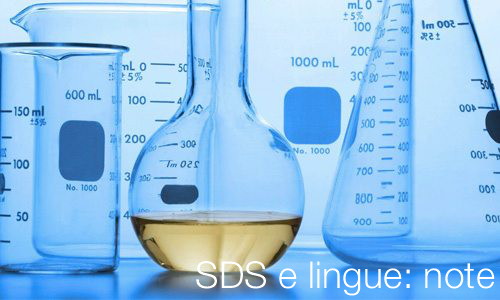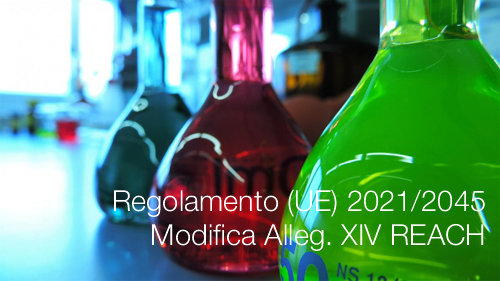Informazione tecnica HSE / 25 ° anno
/ Documenti disponibili:
45.530
/ Documenti scaricati: 34.331.962
/ Documenti scaricati: 34.331.962
Il 16 novembre 2016 si è svolta a Roma, presso l'Auditorium del Ministero della Salute, la 5a Conferenza Nazionale sull'attuazione del Regolamento REACH.
La Conferenza è stata organizzata dal Ministero della Salute, in collaborazione con il Ministero dell’Ambiente e della Tutela del Territorio e del Mare, il Ministero dello Sviluppo Economico con il supporto dell'Agenzia nazionale per le nuove tecnologie, l'energia e lo sviluppo sostenibile, l’Istituto Superiore di Sanità - Centro Nazionale [...]
Joint Research Centre (JRC), rapporto tecnico pubblicato 27 aprile 2017
User guide of selected practices to determine the nature of layers - studio
Guida per l'identificazione di polimeri in film multistrato utilizzati nei materiali di contatto con gli alimenti
Questa guida descrive come caratterizzare la composizione di un film plastico multistrato Per l'imballaggio alimentare, rispetto all'ordine consecutivo degli strati e alla loro identità.
Fornisce informazioni di base [...]
Linea guida sul campionamento per il controllo ufficiale dei materiali ed oggetti a contatto con gli alimenti
Pemessa
Tutti i Materiali e Oggetti al Contatto con gli Alimenti (MOCA) sono disciplinati a livello comunitario dal Regolamento CE n. 1935/2004, detto anche "Regolamento quadro",
che stabilisce i requisiti generali cui i MOCA devono rispondere.
L'articolo 24 del Regolamento CE n. 1935/2004 (Misure d'ispezione e di controllo) prevede che gli Stati membri svolgano controlli ufficiali ai fini dell'osservanza del [...]
27 Aprile 2017 Ministero della Salute
Il Piano è stato predisposto con la collaborazione del Gruppo Tecnico Interregionale REACH - CLP, con il Centro Nazionale delle Sostanze Chimiche, Prodotti Cosmetici e Protezione del Consumatore dell'Istituto Superiore di Sanità e la Rete dei laboratori di controllo in attuazione all'Accordo Stato-Regioni del 7 maggio 2015.
Tipologia di sostanze verso cui orientare il controllo
- sostanze in quanto tali o contenute in miscele [...]
This document addresses the different aspects relating to the safety of on-site rail activities. It does not intent to substitute any company procedures or local, national or international regulations. When local, national or international regulations apply to an activity covered by this guideline, sites shall fully comply with the applicable regulations.
Working on chemical sites is always bound to strict safety rules. Working with or nearby rail vehicles on chemical sites [...]
ID 3893 | 13.04.2017
Linee guida per il riscontro documentale sull’applicazione del Regolamento (CE) 2023/2006. Vernici, adesivi e inchiostri da stampa.
Nell’ambito del Progetto CAST (Contatto Alimentare Sicurezza e Tecnologia) sono state sviluppate schede pratiche commentate per il riscontro documentale sull’applicazione del Regolamento (CE) 2023/2006 sulle buone pratiche di fabbricazione nella filiera di produzione di vernici, adesivi e inchiostri da stampa per materiali e oggetti destinati a venire in [...]
Linee guida per l’applicazione del Regolamento (CE) 2023/2006 alla filiera di produzione di vernici, adesivi e inchiostri da stampa per materiali a contatto con alimenti
Il presente documento costituisce la linea guida per l’applicazione del Regolamento (CE) 2023/2006, per le seguenti filiere dei materiali e oggetti a contatto con alimenti:
- prodotti vernicianti (coating) su metalli;
- adesivi e sigillanti;
- inchiostri da stampa.
Al fine di garantire coerenza con l’approccio definito [...]
A study was conducted to characterize sampling and analysis methods for the measurement of the personal workplace exposure concentration of gas oil vapours and aerosols and in particular, to describe their ability to quantify the aerosol-vapour partitioning.
This project aims to address a deficiency identified in current monitoring methods where the principle focus has been on the aerosol phase of exposure to mists.
Concawe 2015
Because of the growth in the availability and use of cryogenic ethylene in Europe, the European Industrial Gases Association (EIGA) has recognised the need to publish guidance addressing safety in the storage, handling and distribution of cryogenic ethylene.
This EIGA publication is intended as guidance to companies directly associated with the installation of cryogenic ethylene storage at the user's premises and the distribution of cryogenic ethylene by road, rail and sea [...]
Valutazione della situazione attuale per quanto riguarda i materiali a contatto con alimenti per i quali non esistono misure armonizzate specifiche a livello UE
Il regolamento (CE) n 1935/2004 della Commissione è la legislazione quadro per i materiali a contatto con alimenti. Lo scopo del regolamento è quello di garantire l'efficace funzionamento del mercato interno per i materiali e gli oggetti destinati a venire a contatto direttamente o [...]
Questa pubblicazione è una relazione tecnica da parte del Joint Research Centre (JRC), gruppo di ricerca della Commissione Europea, che si rivolge agli Stati membri, principalmente per assisterli nella pianificazione territoriale e per fornire loro un approccio sistematico alla selezione di scenari e di criteri per la pianificazione territoriale, nel contesto dell'attuazione della direttiva Seveso III.
E 'possibile utilizzare gli scenari per la pianificazione di emergenze, i risultati forniti sono interpretati [...]
ID 2879 | Update news 07.05.2023 / In allegato
Materie plastiche (fase di commercializzazione diversa dalla vendita al dettaglio)
Regolamento (UE) N. 10/2011 materiali e gli oggetti di materia plastica destinati a venire a contatto con i prodotti alimentari
Articolo 15 Dichiarazione di conformità
1. Nelle fasi della commercializzazione diverse dalla [...]
ID 1673 | 23.03.2027 / In allegato
Rapporto ISTISAN 23/4 - Progetto CAST (Contatto Alimentare Sicurezza e Tecnologia). Linee guida per l’applicazione del Regolamento (CE) 2023/2006 alla filiera di produzione dei materiali e oggetti destinati a venire in contatto con gli alimenti. Edizione 2023.
Nell’ambito del Progetto CAST (Contatto Alimentare Sicurezza e Tecnologia) sono state sviluppate linee guida [...]
The objective of the document is to help EIGA members and their customers in their dealings with authorities in order to obtain permits for the safe storage and use of toxic gases in transportable containers, in particular in countries where “harm” and “no harm” effect distances are not defined in standards or regulations.
The “harm” and “no harm” distances are calculated in [...]
The document describes best practices of EIGA members for the protection of their workers during operation of any fired heater where Refractory Ceramic Fibres (RCFs) are used, including Steam Methane Reformer furnaces.
The best practices described in this document were developed for RCFs but can also be applied to other high temperature insulation wools.
EIGA 2017
Orientamenti dell'Unione sul regolamento (UE) n. 10/2011 riguardante i materiali e gli oggetti di materia plastica destinati a venire a contatto con i prodotti alimentari, per quanto concerne le informazioni all'interno della catena di approvvigionamento.
Il presente documento orientativo fa parte di una serie di documenti redatti allo scopo di fornire orientamenti sull'applicazione del regolamento (UE) n. 10/2011 riguardante i materiali e gli [...]
ECHA has evaluated the risk of substances in recycled rubber that is used on artificial sports pitches. Based on the evidence, ECHA has concluded that the concern for players on these pitches, including children, and for workers who install and maintain them is very low. ECHA will update its evaluation as and when new information becomes available.
Helsinki, 28 February 2017 – In June 2016, the European Commission asked ECHA to evaluate the risk [...]
In linea con l'articolo 117, paragrafo 2, del regolamento REACH, ogni cinque anni l'ECHA presenta alla Commissione europea una relazione sul funzionamento dello stesso Regolamento REACH. L'Agenzia inserisce nella relazione "le informazioni sulla trasmissione comune dei dati a norma dell'articolo 11 e una rassegna delle spiegazioni formulate per trasmettere separatamente le informazioni.
This is the second five year report the Agency has produced on the implementation of the REACH and CLP [...]
Allegati tutti i documenti d'orientamento che sono disponibili sul sito ECHA. relativi ai biocidi, Regolamento (UE) 528/2012 (BPR)
Il regolamento sui biocidi (BPR, regolamento (UE) 528/2012) concerne l'immissione sul mercato e l'uso di biocidi, utilizzati per la tutela dell'uomo, degli animali, dei materiali o degli articoli contro organismi nocivi, quali parassiti o batteri, mediante l'azione dei principi attivi contenuti nel biocida. Lo scopo del regolamento è migliorare il funzionamento del mercato dei biocidi [...]
Pubblicata la versione tradotta IT ad Ottobre 2015
Versione 3.0 Agosto 2015
Questa guida fornisce informazioni su aspetti di cui tenere conto quando si compila una scheda di dati di sicurezza (SDS), ossia dettagli sulle prescrizioni relative alle informazioni che devono essere presenti in ciascuna sezione di una SDS - in particolare dettagli sulle modifiche derivanti dalle diverse revisioni dell'allegato II di REACH e i periodi [...]
Versione 3.1 Novembre 2015
Questa guida fornisce informazioni su aspetti di cui tenere conto quando si compila una scheda di dati di sicurezza (SDS), ossia dettagli sulle prescrizioni relative alle informazioni che devono essere presenti in ciascuna sezione di una SDS – in particolare dettagli sulle modifiche derivanti dalle diverse revisioni dell'allegato II di REACH (Regolamento (CE) 1907/2006) e i periodi transitori per attuare tali modifiche.
Nella guida viene [...]
Il manuale, aggiornato a dicembre 2016, raccoglie un insieme di raccomandazioni in grado di garantire una gestione sicura dei prodotti fitosanitari nel loro complesso.
È strutturato in capitoli specifici e illustra le diverse fasi che vanno dal momento dell’acquisto fino a quello dello smaltimento dei contenitori. Nelle diverse fasi vengono evidenziati gli aspetti più rilevanti nell'ottica di minimizzare i potenziali rischi di contaminazione di tipo puntiforme e, contestualmente,
Anno 2015
Il documento intende fornire un quadro nazionale delle attività di controllo, effettuate nel corso dell’anno 2015, per la verifica di conformità dei prodotti chimici al Regolamento (CE) n. 1907/2006 (REACH) e alla normativa in materia di classificazione, etichettatura ed imballaggio delle sostanze e delle miscele in attuazione del «Piano Nazionale dei Controlli sull’applicazione del Regolamento REACH-CLP Anno 2015», adottato dall’Autorità Competente Nazionale REACH-CLP, presso la DG Prevenzione sanitaria del [...]
Linea Guida Assogastecnici per la redazione di Etichette e Schede di Dati di Sicurezza per le principali categorie di Miscele
Etichette e Schede di Dati di Sicurezza (SDS) sono uno dei tanti esempi di interazione tra i Regolamenti REACH e CLP, in quanto sono regolamentate dal primo e influenzate dai criteri di classificazione previsti dal secondo (che, ricordiamo, si rifanno al GHS, il sistema globale armonizzato della classificazione ed etichettatura delle sostanze chimiche promosso dall’ONU)
Documento orientativo per la classificazione dei prodotti fitosanitari in applicazione al Regolamento (CE) 1272/2008
Il presente documento offre una serie di orientamenti di base in merito alle modalità operative ed ai criteri stabiliti dal nuovo Regolamento (CE) 1272/2008 relativo alla classificazione, all’etichettatura e all’imballaggio (Classification, Labelling and Packaging, CLP) delle sostanze e delle miscele entrato in vigore il 20 gennaio 2009 negli Stati membri dell’Unione Europea.
In particolare, il presente lavoro rappresenta un documento di orientamento per la [...]
Formato: doc
The CSR template (section 9 and 10) suggests how the information as required in Annex I of REACH can be reported.
1. Chemical Safety Report - (Section 9 and 10) for non PBT/vPvB substances
2. Chemical Safety Report - (Section 9 and 10) for substances (considered as) PBT/vPvB
Sections 1 to 8 of the CSR Part B can be generated by the CSR IUCLID plug-in:
https://iuclid.eu/
ECHA 2017
Regolamento (CE) n. 1907/2006 REACH
REACH Allegato I
Disposizioni generali [...]
The European Chemicals Agency (ECHA)/semiconductor industry collaboration was established to gain practical experience in generating exposure scenarios (ESs) that would be integral elements of the chemical safety report (CSR).
The examples are related to industrial use of three substances in production of semiconductor devices (“microchips”).
Project participants strove to achieve a high level of understanding of semiconductor (SC) processes through information sharing and a site visit to observe actual semiconductor manufacturing operations. Although not all [...]
Guida CLP - IT 2a Edizione 09.2016
Guida all'etichettatura e all'imballaggio a norma del regolamento (CE) n. 1272/2008 - CLP
Il presente documento descrive le disposizioni specifiche per l’etichettatura e l’imballaggio di sostanze e miscele chimiche di cui ai titoli III e IV del regolamento (CE) n. 1272/2008
(regolamento CLP o "CLP").
Lo scopo del presente documento è assistere i fabbricanti, gli importatori, gli utilizzatori a valle e i distributori di sostanze e miscele nell’efficace [...]
The Guide helps suppliers and recipients of safety data sheets to compile and understand substance and use information.
The Guide was originally an interactive online publication that provided information for the recipients of safety data sheets and exposure scenarios in a user-friendly way. It has now been updated to include useful tips for suppliers on issues to watch out for within each section.
At the same time, it has been converted into [...]
Classification, and Labelling guide in accordance with EC Regulation 1272/2008
The document gives guidance for the classification and labelling for products that meet all of the following criteria:
a) the products are defined as “gases” according to the CLP Regulation with the addition of two liquids (Hydrogen fluoride and Methylbutene)
b) they are all allowed to be put on the market in the EU i.e. they have either an EC number, they have been pre-registered or registered [...]

ID 10175 | 17.02.2020 - Scheda completa allegata
In Italia con il D.lgs. 14 settembre 2009 n. 133, è stabilita la disciplina sanzionatoria per l...

Regolamento (UE) 2022/1181 della Commissione dell'8 luglio 2022 che modifica la premessa dell’allegato V del regolamento (CE) n. 12...

Regolamento (UE) 2021/2045 della Commissione del 23 novembre 2021 che modifica l’allegato XIV del...
Testata editoriale iscritta al n. 22/2024 del registro periodici della cancelleria del Tribunale di Perugia in data 19.11.2024